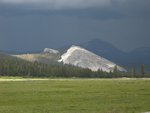Restoring and Rehabilitating Popular Cave Rock
John Maher, Lake Tahoe Basin Management Unit Heritage Program Manager
The Lake Tahoe Basin Management Unit (LTBMU) recently completed a project to restore the historically, culturally and archaeologically significant site of Cave Rock, by removing climbing hardware, concrete and flagstone flooring, and graffiti.
Cave Rock is a remnant of a volcano that erupted over 3 million years ago and is located on the southeastern shoreline of Lake Tahoe. The area is sacred to members of the Washoe Tribe of Nevada and California, the native people of the Lake Tahoe Region, since time immemorial. The tribe considers Cave Rock a place of extreme power and it continues to be used by traditional practitioners. Cave Rock has been determined eligible to the National Register of Historic Places as a Traditional Cultural Property of the Washoe, a historic transportation corridor, and a repository of archaeological and paleobotanical information.
Many alterations to Cave Rock have occurred over the past century and a half. An emigrant road was constructed over the top; a trestle road was built around it; and two tunnels were blasted through it. The cave itself has been defaced with graffiti and most recently the rock became a popular rock climbing destination. During the 1980s and 90s, rock climbers placed approximately 350 bolts and hangers with assorted climbing paraphernalia, including slings, chain cable and string. Additionally, a climber laid a concrete, paving stone, and gravel floor within the cave.
The Cave Rock Management Direction Environmental Impact Statement was completed in 2003. One aspect of the decision was to “Remove all climbing hardware, concrete and rock improvements from the Cave's floor and entrance and non-historic graffiti to the extent feasible.” After several years of appeals and litigation, this part of the decision has been implemented.
In 2009, the LTBMU received $25,000 in Heritage Program funding for restoration and rehabilitation needs. LTBMU contracted with a local landscaper to remove: 350 bolts and paraphernalia; approximately 5 tons of concrete, gravel, and paving stones; and approximately 35 linear feet of graffiti.
The contractor rappelled to the climbing areas using a bosun's chair as a platform, removed the bolts with a ratchet wrench, extracted the sleeve when possible with a special tool he devised, and then inserted a stone plug sealed with adhesive to protect the hole from further erosion from water pooling inside. The concrete cave floor was broken up with a jackhammer and removed. Graffiti was sandblasted and the edges were feathered to soften the appearance of the abraded areas.
The contractor and LTBMU worked extensively with the Washoe Tribal Historic Preservation Officer to perform the work in a manner that respected the sensitive nature of the site.
http://www.fs.fed.us/r5/spotlight/2010/caverock.php
Restoring and Rehabilitating Popular Cave Rock
All posts are those of the individual authors and the owner
of this site does not endorse them. Content should be considered opinion
and not fact until verified independently.
Sorry, only registered users may post in this forum.


